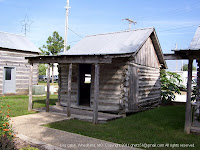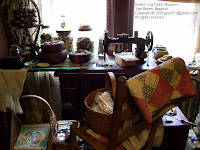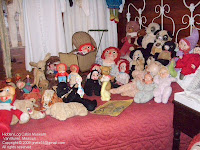History preserved in Van Buren, MO
Wanda Newton is the owner of the Hidden Log Cabin Museum in Van Buren, MO. She was born and raised in Van Buren, but she lived in Chicago for a while as a young adult. When she came back to Van Buren, she was surprised how times had changed. The old ways of Ozark life were being abandoned.
Miss Wanda noticed that antique dealers from distant cities often attended estate auctions and farm sales in Carter County. She watched the dealers leave with their loot, and she worried that Carter County was losing its history, one auction at a time. She decided to start a collection of items that would be representative of life as it had been.
It was a good thing that her husband supported her, Miss Wanda says, because the auctions took all the money she made at her courthouse job. She dreamed of having a place to put her collection on display.
The hidden log cabin
Finally, an opportunity opened. The house next door to her home was put up for sale, and Miss Wanda bought it. Despite its mundane exterior, it was no ordinary house. Under the siding, it was a log house with several frame rooms built onto it.
And it was an exceptionally historic log cabin. The little village of Van Buren, on the west side of the river, was burned during the Civil War. When the war ended, the residents decided to rebuild on the east side of the river. The first building that went up was a new Carter County courthouse.
When the lots for the new town were surveyed, it turned out that the courthouse had been built in the middle of the street. It was moved back a few yards, onto the corner lot of John and Ash, and there it still sits.
When Miss Wanda became the owner, she undertook a massive restoration. She stripped the log room down to its whitewashed walls of hand-hewn native pine. The large yawning fireplace had been closed off and partially torn down, so she hired a stonemason to rebuild it. She didn't have enough money for the project, so she borrowed from her husband. It took her a couple of years to pay him back.
In the other rooms, she removed modern wall coverings to reveal the walls as they had been when the addition to the house was built. She did most of the work herself, and it took her several years.
Tour of the museum
When I visited the Hidden Log House Museum, Miss Wanda walked me through the first room and told me about it. "Don't you want to take any pictures?" she asked. I told her that I would take pictures on my way back through the house, but first, I wanted to give my full attention to what she was telling me. Every item in the house has its history, of course, and Miss Wanda is a good storyteller.
So, these photos are in reverse order, starting from the back of the house in the kitchen and summer kitchen and ending in the log room which is at the front of the house.
On the back wall of the kitchen, there's a large, antique sink. Miss Wanda's sister, now in her early 90s, washed dishes in that very sink as part of her room and board when she attended high school. (It was in another house at the time.) I should have taken its picture, but I didn't. I also regret that I didn't take a picture of Miss Wanda.
The center room of the house was probably a dining room or parlor, and it has a bedroom on the side of it. Miss Wanda left the first layer of wallpaper-- a bold burgundy and white pattern -- on the dining room walls.
The big memory jug is old; the small memory jug in front was made in recent years. Just in front of the chair, a small bowl holds some bits of jewelry and small mementos. There's also a jar of buttons. These are the sorts of things that people used when they made memory jugs and jars. Miss Wanda is not sure what sort of adhesive was used in the old memory jug, but the newer one was made with window putty.
Miss Wanda says to watch for the "Knickerbocker" label when you are at a sale that has old stuffed toys. Someone in her family liked to laugh about her stuffed animals, and as sort of a joke, gave her a book about collecting them. When Miss Wanda looked up some of her stuffed toys in the book and showed the relative their value, he didn't tease her anymore.
The photos that follow are in the log room that was the Carter County Courthouse for a number of years. I'm amazed that Miss Wanda was able to find and buy all the items displayed here. She says she collected all these things in Carter County and the surrounding counties. The antique furniture you see in this room is handmade, and many of the other items are also.
I was surprised how much room the spinning wheel took. Miss Wanda told me that she used to have a loom, too, but it took up twice as much room as the spinning wheel. She finally sold it to a lady who weaves.
The coverlet on the bed was woven on a loom over a century ago, with handspun wool yarn. I believe Miss Wanda said that she made the rag rug in the bottom photo herself.
Miss Wanda receives no funds for the museum beyond what she charges in admission. She has decided not to have the house declared a historic site because she's afraid of the restrictions and obligations it might bring. She closes the museum over the coldest months of winter so she won't have to heat it.
Sometimes, classes of school children spend an afternoon at the museum and Miss Wanda enjoys telling them about the simple lives of the people who lived in the Ozarks a few generations ago. But what she likes best, she says, is when someone stops who is really interested -- someone who asks questions and wants to take pictures. It absolutely makes her day.
On the web:
A
description of the Hidden Log Cabin Museum in Patti DeLano's
Missouri Off the Beaten Path.
Related post:
Van Buren, Missouri





















































